
Demystifying Coffee Acidity: Is Your Low Acid Coffee Lab-Certified for pH Levels?
If you are looking for a low acid coffee, you better know your pH. I am not saying that you need to understand all the scientific details of pH testing or of the laboratory analysis process and it’s methodology. What you need to know is that as a coffee drinker, the pH is the single most important tool for locating a coffee that will not negatively affect your health. But if you are looking at the numbers only, I will tell you those numbers can be deceiving.
It is true that you need to understand the final score of the coffee. You should be aware that most low acid coffee companies do not even reference finished pH scores. If they do, the results usually are not posted and they are almost never conducted by an independent 3rd party laboratory. However, the laboratory piece of the analysis of the coffee bean is nearly as important as the score itself.
In this post, I want to explain how to select the right coffee using the finished pH and, just as importantly, explain the necessity of that score being lab certified.
Let's look at the certified analysis process to set the groundwork.
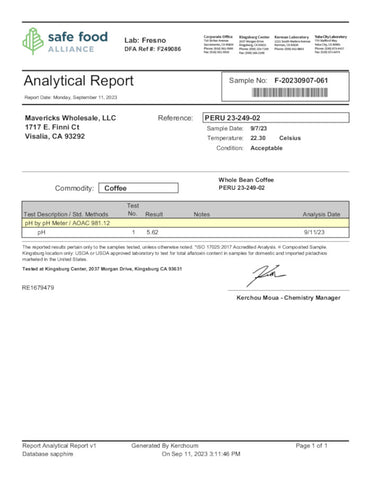 Testing Coffee for pH: The Lab
Testing Coffee for pH: The Lab
Laboratory analysis is the process that undergirds the information you will use to make the coffee purchasing decision that can impact your health. To analyze our coffees and certify its pH level, we contract with a lab that is ISO and AOAC compliant. These are few of the reasons why.
ISO Testing
The International Organization for Standardization (ISO), is an independent, non-governmental international organization of membership of 170 national standards bodies. This membership can share knowledge, collaborate, etc. to develop voluntary, compliance standards.
As noted in the Analytical Peport I have posted with this article, the labs we use conform to 17025:2017 standards. What is 17025:2017? According to the ISO, these parameters “specifies the general requirements for the competence, impartiality and consistent operation of laboratories”....and …“is applicable to all organizations performing laboratory activities, regardless of the number of personnel.
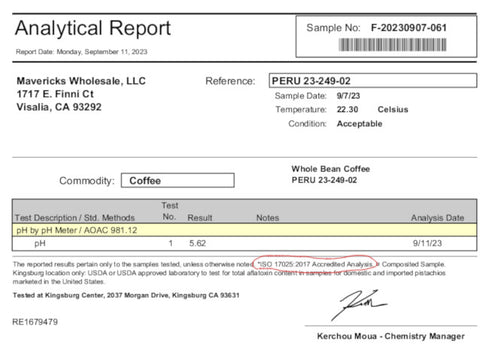 If it interests you, visit their website to learn more about laboratory environments. My point is that standards and guidelines are used by labs domestically and internationally. https://www.iso.org/standard/66912.html
If it interests you, visit their website to learn more about laboratory environments. My point is that standards and guidelines are used by labs domestically and internationally. https://www.iso.org/standard/66912.html
Now back to our Analytical Report. This report and analysis of the subject coffee was conducted in an independent fashion at a dedicated professional lab based on a knowable standard. That means no thumbs on the scale and the analysis can be conducted and understood regardless of where it was conducted from California to Japan.
Testing Coffee Acidity: Method of pH Testing
The Analytical Report was performed using a pH meter, more about that in a minute, using AOAC 981.12 process. A little web research leads us to AOAC International. In their own words the stated purpose of “ AOAC INTERNATIONAL brings together government, industry, and academia to establish standard methods of analysis that ensure the safety and integrity of foods and other products that impact public health around the world.”
AOAC Testing
You can even look up the the following methodology used by Food Safe Alliances on the Analytical Report of our coffee: AOAC Official Method 981.12 pH of Acidified Foods.
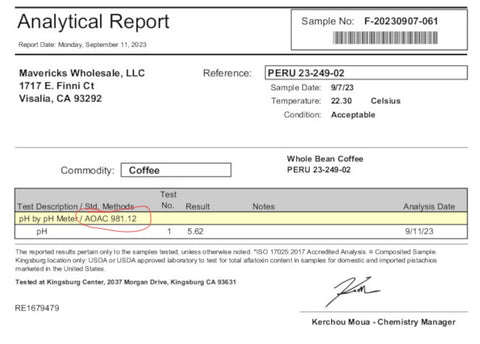 This is the same basic idea with AOAC as with ISO, development of an independent consensus-based standard to be referenced against when conducting an analysis of food samples. In this case, coffee and its pH level.
This is the same basic idea with AOAC as with ISO, development of an independent consensus-based standard to be referenced against when conducting an analysis of food samples. In this case, coffee and its pH level.
I am not a lab guy. I had my High School science classes and tried to take as few college science classes as possible. However, the benefits of these standards and parameters are obvious. Pardon me if I over-simply. Essentially, you can get an apple to apples comparison.
It allows you to utilize the same parameters and methods and duplicate the testing by holding those variables constant. That allows me as the roaster to focus on developing a roast profile and deal with my own variables that need controlled and not think about the lab. I can actually have a set standard to allow me to focus on being a roaster and not a lab tech (what a relief)!
For the consumer, you now know that the coffee is analyzed in a verifiable way based on an understandable scientific standard, and the analysis is not biased by some guy trying to sell you a bag or coffee. For more on AOAC look here. https://www.aoac.org/official-methods-of-analysis/
Equipment: pH Meter
I have written on the equipment in other places. But let me just say simply, the laboratory uses professional grade testing equipment. In this case a pH meter, that is more accurate and calibrated to exact parameters. You get the picture.
To be honest, I think your making decisions that can affect your health by relying upon me standing in a warehouse in California using a litmus style test strip, does not exude confidence.
Plus, even if I had all the right gear. What do I know about performing laboratory analysis? You need to be a trained professional.
Here is an example. I did not notice until recently that on the Analytical report the test was conducted aqueous solution had to be at a precise temperature. Yes, temperature does make a difference.
Temperature:
Temperature can affect the measurement of pH of a coffee. While the actual concentration of acidity remains unchanged, the measurement can be affected by the temperature. That means the reading and hence the scoring can be off and by a lot. You will see in a minute based on the logartemic nature of the pH scale, a slight difference can make a big deal. It could be the difference between an enjoyable cup and or experiencing acid reflux.
Control Conditions
Another benefit of the lab environment is not only can they control the testing conditions, the parameters of the test are also controlled per universal guidelines and practices as I mentioned above with ISO standard and AOAC methodology. For example, I had no idea that the accepted temperature for conducting a pH test is 17.6 C, which is 63.68 F. If I had just made a hot brewed coffee and inserted a litmus style test strip the reading and hence the score would be wrong.
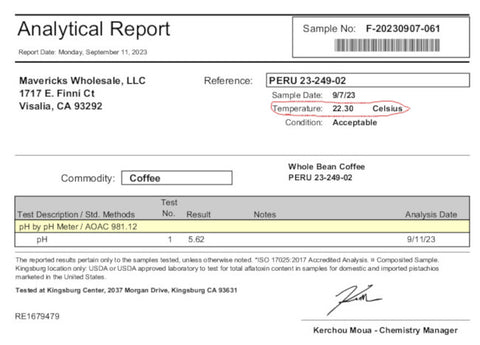 Now lets look at the pH score and pH scale.
Now lets look at the pH score and pH scale.
Measuring pH of coffee beans
So how do they measure pH? The lab uses an "aqueous solution". The term aqueous solution is a fancy phrase for a solution where water is the solvent. The coffee is mixed with the solution (water) and then measured by a testing device. The solution needs to be at 63.68F.
The Chain of Custody:
Once we roast the coffee beans, we no longer control the product sample. The Lab picks it up with a sample sheet detailing the date, batch number, and coffee.
The lab runs conducts the testing with the aforementioned parameters as set forth by 17025:2017 and AOAC 981.12. The results of the analysis and then communicated to us electrically on the lab's standard analytical report. No thumbs on the scale here. It is a true number, and we would get the same result time and time again whether the sample was tested at a lab in Kingsburg, CA or Dublin, Ireland.
Outside of the lab component, how accurate are the results with each batch of coffee? It is a widely understand that every batch of coffee is slightly different from the previous roast. So how close can the pH levels be from one batch to the next. The answer is surprisingly close. It is so close it is scary.
So here is a series of analyses from 5 batches of coffee we did over three days. The subject coffee is from the country of Peru and roasted as a single origin. This is our lightest roast and will contain the most acid of any of our low acid coffees even though it is much lower in acid than nearly all other coffee available today.
Origin Lot Score:
-
Peru 23-248-03 / pH 5.63
-
Peru 23-249-02 / pH 5.62
-
Peru 23-249-03 / pH 5.63
-
Peru 23-250-01 / pH 5.60
-
Peru 23-250-02 / pH 5.61
The lot numbers tell you the specific day of roast, and batch number for that day, and the coffee designating its origin. The Analytical Report also gives you a scoring of the roast based on the methodology and practice that I have referenced above. These results are then posted on our website to verify to the consumer the low acidity levels of our slow roasting process.
That is the process in a nutshell. It eliminates a lot of variables and issues and, most importantly, deliveries the most accurate and honest assessment for you the customer to make an informed decision. It’s your health, shouldn't it be this way?
The significance of pH for a coffee drinker.
I appreciate your reading through all that, which I believe needs to be said to give you the context, importance, and meaning behind what these pH numbers mean.
Coffee pH By The Numbers
Now the significance of the numbers themselves. Logarithmically Mavericks Peru, which is the subject coffee of the analysis is on average 70% less acidic than national chain coffee producers, regional roasters, local roasters, and virtually all other coffee purveyors in the United States.
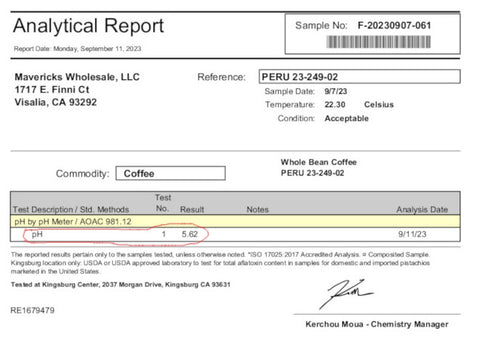 For Mavericks, the Peru has been scored at 5.5 pH over the years. However, the most recent 5 batches of Peru now score 5.6 or greater. This is an additional 10% reduction in acid concentration in the subject coffee. So Peru now stands at having 80% less acid than virtually any other coffee company that is producing a non low acid coffee.
For Mavericks, the Peru has been scored at 5.5 pH over the years. However, the most recent 5 batches of Peru now score 5.6 or greater. This is an additional 10% reduction in acid concentration in the subject coffee. So Peru now stands at having 80% less acid than virtually any other coffee company that is producing a non low acid coffee.
Coffee pH Logarithmically Measured
This is how it works logarithmically. For every ascending percent change along the pH scale of 0.1% it reduces the acidity level by 10%. The relationship is inverse. The less acid the higher the score.
For example: Our Peru was scored at 5.5 and now is scored at 5.6. That is a 0.1% increase in pH (less acid), the concentration of acid was actually not by .1% but 10%, because of the nature of the scale.
One more thing I wanted to draw your attention to from our most recent analysis, is why the change in the score of our Peru.
Why the Change in pH Levels:
As I have written in my other articles. The simplest and most effective means of reducing acidity levels in coffee is by the roast. At the country of origin, cultivation methods, processing methods, and other factors can have a slight impact in concentration of acid, however roasting is the best way to reduce acidity and slow roasting is the most effective means of the coffee's acidity reduction because it based on time and temperature; two of the variables of any roast.
By modulating the heat during the profile we were able to reduce the acidity in the Peru by an additional 10%. Affecting the the level of acid concentration more effectively then any methods that could be employed at origin without a unacceptable effect on taste and quality.
Slow roasting allows us to not only control the finished pH score of the coffee, without any additional processing, steps, or introducing other processing agents, that can affect its organic compliance, but it also allows us to maintain a consistently smooth and desirable coffee for your palate.
Takeaways for Coffee pH
Look for coffees that finish 5.5 or better on the pH scale and are lab certified. Finding an organic low acid coffee is a great idea also, because it eliminates any issues your body might have with non organic processing agents or methods. Another bonus is that all organic coffees and non GMO.
If you are looking for a decaf, see my article on water process decaf low acid coffees and how to avoid decaffeination processes that utilize chemical solvents.
- Ryan
FAQ
Is Coffee Acidic or Alkaline?
Coffee is very acidic. For people with sensitivity to acid in their diets, coffee consumption can contribute to acid reflux and other symptoms. Coffee is full of organic acid compounds such as malic acid, citric acid, and chlorogenic acid to name a few. This is why coffee drinkers are told avoid coffee due to the high acidity and look for coffees for low acid coffee that have a much lower acidity.
Does Acidity in Coffee Affect Flavor
When discussing taste, acid can refer to brightness or liveliness and is an important cupping attribute when scoring a coffee's quality. In general the more acidic cup, the more acidic flavors. Perceived acidity is seen as positive. But coffee acidity levels can also accentuate bitter flavors. However, when taking about acidity as it relates to the concentration of acid levels in the coffee beans it can be detrimental to peoples health. This is why a low acid coffee should be less bitter and easier on your digestive system. Low acid coffees target chlorogenic acids and other acids that to lower the acidity level.